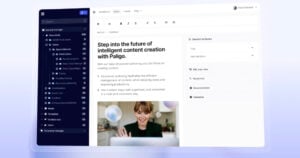- Home
- Blog
- Technical writing
- The Best Technical Writing Platform for Instructional Content
The Best Technical Writing Platform for Instructional Content
Share

Effective communication and knowledge sharing are paramount to organizations. Processes change, new products get implemented, and others get updated. Instructional content documentation plays a pivotal role in equipping employees and stakeholders with the skills and information they need to do their jobs.
Creating and managing instructional content can happen in many ways using different technologies. In this blog, we’ll show you why we believe the Paligo CCMS is the best technical writing platform for writing your training content. But first, let’s consider the need for instructional (or training) content.
The Importance of Instructional Content Documentation
Many companies provide training to employees in the form of instructional content to teach specific skills, convey important information, and help them understand or use products, services, and processes effectively.
Typically offered through a learning management system (LMS), instructional content facilitates learning by providing a focused, organized approach to the information, followed by quizzes or assessments to ensure the information has been understood.
The traditional approach to creating and managing instructional content is through using tools like Microsoft Word or Google Docs and uploading it to the LMS, or creating the content directly in the LMS.
The challenge with these approaches is that technical writers often duplicate content that is already in your CCMS (component content management system). When that content is updated, writers must manually update their learning content.
Manage Your Instructional Content in Your CCMS
A better approach is to create and manage your training content where you manage your technical documentation. The Paligo CCMS is a great example of why and how you can manage instructional content documentation efficiently that ensures the content is always up-to-date, available in the languages you need, and is still easy to upload to your LMS.
Because the Paligo CCMS is a component content management system, it supports creating and managing structured content, including technical documentation, policies and procedures, knowledge management, instructional content, and more. Technical writers use it to create and deliver many types of content in multiple formats or locations.
Let’s look at some capabilities in Paligo that support instructional content, and then we’ll go through the key benefits for technical writers.
Capabilities for Creating Instructional Content
With Paligo, you create and manage content using a structured content model. This enables you to break up your content into topics that you can reuse for multiple content assets, such as a knowledge base article, a product guide, or a training topic. As you update your content, everywhere that content is reused will also be updated automatically. As a result, you can always be sure that your content is accurate and up-to-date. This includes your training content.
As a technical writer, you know the value of structured, reusable content and can see how managing your instructional content in a CCMS makes sense. But let’s look at some other Paligo capabilities that benefit the management of training content.
Simplified Workflows
Setting up an eLearning course in Paligo is the same as creating any new publication. You create a new eLearning publication, which acts as a table of contents. Then, you start adding information topics that make up the training.
You can also create quiz topics (which we’ll come to next). After all your topics are created, organize them accordingly (so your quizzes come at the end of a set of lessons), then create a layout and publish it.
It’s the same straightforward workflow you follow for creating other publications (without the quizzes).
Quizzes and Assessments
Every course has a set of quizzes or assessments that occur after a set of lessons or at the end of the course to check that the learner has understood the material. Paligo provides a Quiz module that enables you to build the quiz and add it to the appropriate location in the eLearning publication.
You can create numbered and multiple-choice questions. When the course is uploaded to the LMS, it can track progress and scores. This is another opportunity to reuse content; you can reuse questions across quizzes or assessments.
User-Friendly Editor
Authoring content is also easy in Paligo. It offers a user-friendly editor where you can create new content. Although all content is stored as XML, Paligo hides the code to simplify the writing process. Removing the complexity of writing in XML using the toolbar or element context menu enables you to create content quickly and supports content creation by technical and non-technical staff.
However, if you want to see the XML, you can view the structure in the Element Structure Menu, XML Tree View, or Source Code Editor.
Comprehensive Content Library
If you manage all your technical content in Paligo, you have access to a comprehensive library of content for your eLearning courses. You don’t have to start course lessons with a blank page, instead leveraging previously created content wherever possible.
Creating information topics (or course lessons) is no different from creating topics for online help, knowledge base articles, product guides, or other documentation. Add paragraphs, images, admonitions, text fragments, and other types of content. Create brand-new topics or reuse existing topics. Do you have an overview of a product created for your product guide? You can use that as the first lesson in your product course. A checklist for creating a new insurance policy? Reuse it as a part of a lesson.
As your products or processes get updated, your course content is also updated. You might need to adjust a quiz or assessment, but you won’t have to recreate all the course content. Content reuse dramatically reduces the time it takes to create and update courses.
Key Integrations
Let’s talk about integrations. You manage content in the Paligo CCMS for your eLearning courses, but it’s not delivered there. You need to publish it somewhere.
Paligo directly supports SCORM, a technical standard for eLearning products. Content is published as a Zip file, which you then upload to your chosen LMS. If you publish your course in multiple languages (which is easy to do in Paligo), Paligo produces a separate Zip file for each language.
You can also publish your instructional content to other locations or formats. Perhaps you want to publish it as a PDF training manual or upload it to a git repository; Paligo provides many and varied publication channels.
User Benefits for Creating Instructional Content in Paligo
We could talk about the features of the Paligo CCMS that support creating and managing instructional content all day. But what are the key benefits to you as the author, editor, or reviewer of that content?
The Paligo CCMS is super easy to use. The interface is clean and easy to understand. But don’t take our word for it. A typical customer review reads: “Paligo’s UI allows myself and more junior members to jump right in.” Even non-technical writers can create instructional content in Paligo. The content review process is streamlined, enabling SMEs to review the content quickly and approve it or offer comments.
And authors can quickly find relevant information. The Paligo CCMS provides a quick search, a more advanced search, and the ability to find content by taxonomy tags. You can also filter your search by the type of resource you need (image, text, admonition, and so on). Also, there’s the benefit of not having to write all your training content from a blank page but instead, search and find relevant content to reuse.
Another benefit is the ability to localize your training content into multiple languages. Paligo integrates with translation management systems, or you can manage translations directly in the CCMS. When you publish your eLearning course, you select the language to publish, and Paligo creates a separate Zip file for each language. As content is updated in the primary language, translators are notified of the changes, and the translation process begins.
Ready to Create Instructional Content in Paligo?
Instructional content serves as the backbone of effective training within organizations. The Paligo CCMS dramatically improves the way instructional content is developed and maintained. With Paligo, you can streamline content creation through structured content models, simplified workflows, and enhanced engagement with quizzes and assessments. The user-friendly editor and comprehensive content library empower authors to work efficiently and leverage existing resources.
The Paligo CCMS enables organizations to stay agile, maintain up-to-date instructional content, and drive effective learning experiences. If you’re looking for a better way to manage your eLearning content, ask us for a demo.
Share
Author

Barb Mosher Zinck
Barb Mosher Zinck is a senior content marketer and marketing technology analyst. She works with a range of clients in the tech market and actively tracks and writes about digital marketing, customer experience and enterprise content management. Barb understands the value of technology and works hard to inform and encourage greater understanding of its role in the enterprise




